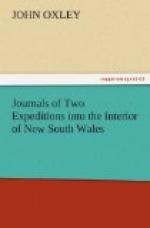A range of very lofty hills and narrow valleys alternately form the tract from Cox’s River, for a distance of sixteen miles, until the Fish River is arrived at; and the stage between these rivers is consequently very severe and oppressive to the cattle: to this range the governor gave the name of Clarence’s Hilly Range. Proceeding from the Fish River and a short distance from it, a very singular and beautiful mountain attracts the attention, its summit being crowned with a large and very extraordinary looking rock, nearly circular in form, which gives to the whole very much the appearance of a Hill Fort, such as are frequent in India; to this lofty hill, Mr. Evans, who was the first European discoverer, gave the name of Mount Evans. Passing on from hence the country continues hilly, but affords good pasturage; gradually improving to Sidmouth Valley, which is distant from the pass of the Fish River eight miles. The land here is level, and the first met with unencumbered with timber: it is not of very considerable extent, but abounds with a great variety of herbs and plants, such as would probably highly interest and gratify the scientific botanist. This beautiful little valley runs north-west and south-east, between hills of easy ascent thinly covered with timber. Leaving Sidmouth Valley the country again becomes hilly, and in other respects resembles very much the country to the eastward of the valley for some miles.
Having reached Campbell River, distant thirteen miles from Sidmouth Valley, the governor was highly gratified by the appearance of the country, which there began to exhibit an open and extensive view of gently rising grounds and fertile plains. Judging from the height of the banks and its general width, the Campbell River must be on some occasions of very considerable magnitude; but the extraordinary drought which has apparently prevailed on the western side of the mountains, equally as throughout this colony for the last three years, has reduced this river so much, that it may be more properly called a chain of pools than a running stream at the present time. In the reaches, or pools of the Campbell River, the very curious animal called the water mole (ornithorhynchus paradoxus), is seen in great numbers. The soil on both banks is uncommonly rich, and the grass is consequently luxuriant. Two miles to the southward of the line of road which crosses the Campbell River, there is a very fine rich tract of low lands which has been named Mitchel Plains.




